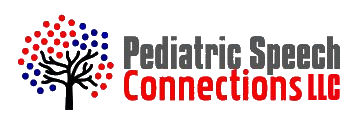Our Services
People often wonder what does speech therapy encompass? There is a detailed delineation of what we cover at Pediatric Speech Connections below. The clinician is well versed in addressing the areas below, which are commonly seen as symptoms of a broader disorder/ diagnosis.
Focus is on the pediatric population, and providing individual therapy sessions. Sessions are tailored to meet the needs of the child; they can be play based for younger students, more structured for older students, or a combination as best suited.

The following areas fall within the scope of practice at pediatric speech connections (PSC):
Delayed talkers
Late language emergence (LLE) is a delay in language onset. It is diagnosed when language development trajectories are below age expectations. Toddlers who exhibit LLE are referred to as “late talkers” or “late language learners”, and may be at risk for developing language and/or literacy difficulties as they age. Divya has extensive experience working with late talkers, and uses a play-based approach embedded with evidenced-based practices to help them meet their milestones.
Oral-Motor Impairments
Children with oral-motor impairments have trouble controlling their lips, tongue, jaw, and cheek muscles. These facial muscle groups are the foundation for future speech and feeding skills. Very often, weakness in one or more of these muscle groups is the underlying cause for delayed/disordered speech and/or feeding. Some signs are if your child drools, has a frequent open-mouth posture, cannot maintain an appropriate lip seal during mealtimes, or has distorted speech. Divya firmly believes that effective therapy is like a dance, where the clinician skillfully assesses and treats not just the symptoms but also the root cause using specific exercises to strengthen identified muscle groups.
Childhood Apraxia of Speech
Children with this disorder know what they want to say, but have difficulty with the motor planning required; it is a deficit in the finely-tuned sequence of movements required by the various articulators (lip, tongue, jaw) to say the words they intend to say. Thus, this is not caused by muscle weakness. Children with apraxia are better able to imitate single words than longer sentences. They are better able to say rote phrases or sing rote songs such as “ABC”. Divya uses her PROMPT training combined with concepts of shaping behaviors to help children approximate target words initially. She carries them from this to a place of precise formation of words by providing firm tactile cueing techniques (PROMPT).
Language Disorders
‘Language’ is a broad term used to describe receptive and expressive components of how we communicate. Thus, a language disorder is an impairment of one or both of these components. Receptive and expressive language encompasses, but is not limited to, comprehending directions, asking and answering questions, grasping vocabulary and concepts, and expressing needs and wants. Children are expected to say their first word at 1 year, 2-word phrases at 2 years, and 3-word phrases at 3 years. As children get older, they are expected to use longer phrases with increasing complexity, increase their vocabulary, and be able to comprehend written and spoken directions. Some children with language disorders may have difficulty with one or more of these skills, while others will require more support. Divya is able to tailor each child’s treatment plan using structured tasks embedded in research-based evidence.
Speech Sound Disorders
Patterns of speech that are not age appropriate or developmentally expected can be addressed within PSC. A child should be 25% intelligible at 1.5 years, 50-70% intelligible at 2 years, 80% intelligible at 3 years, and 90% intelligible at 4 years. Some children demonstrate phonological processes, which are a class of errors; these are developmentally appropriate, until a certain age. If children continue to demonstrate these processes beyond the expected age of disappearance, it is considered a disorder. Other children in the elementary school years misarticulate ‘r’, or have a lisp (incorrect ‘s’ production); this is considered an articulation disorder. Divya’s experience and PROMPT training are key in assessing and treating the underlying causes for such articulation errors. Therapy in the toddler age group to address speech delays looks like play, but is embedded in evidenced-based practice techniques. Moving onto the preschool population, therapy begins to look more structured. The key to treating children in the elementary-years is teaching the ‘new’ way of making the target sound vs the ‘old’ way. Teaching correct placement using modeling, utilizing a hierarchy treatment method, and embedding self-monitoring skills within each session are the key ingredients for success! No matter the age, a connection is always made with the child in order to motivate.
Autism Spectrum Disorders
Autism is a neurodivergent disability that is characterized by differences seen in language, socialization, and repetitive thoughts/actions, but these differences are not always easy to spot, and as a result many adults and children go undiagnosed or misdiagnosed. Because the vast majority of people understand Autism only in extremes and because the majority of information available about Autism is painted in a negative light, a stigma is attached to the diagnosis and caregivers are often afraid when it is brought up. But the truth is, Autism is not wrong or bad. Autism is simply a difference in the brain. It can impact people in a variety of ways, some more significantly than others.
Divya’s first passion has always been working with young children with autism, and the families of these children. Like all children, if progress is going to be made, a connection with the child has to first be cemented. Divya’s years of experience has enabled her to use her skills and intuition in making that connection, and then making progress by following evidenced based practices that: develop joint attention skills, reduce echolalia, and increase receptive language skills, and then expressive language skills. Do not hesitate to call, especially if you are concerned and would like to rule out Autism.
What are some signs of Autism to look for in young children? Here are some (but not all):
-uses few or no socially motivated gestures, such as showing, pointing, or waving by 18mo
-reduced eye contact with others
-reduced joint attention (this is when you and your child demonstrate shared interest and attention toward a common focal point) by 18mo
-reduced ability to imitate simple actions e.g. clapping, waving, stomping feet, stirring spoon in cup
-language regression of more than 10% of words
-echolalia/scripting after the age of 2.5yrs
-child is able to label items (or knows all their ABC’s, numbers, colors) but struggles requesting wants/needs
-if the caregiver or therapist has concerns in two or more areas of Autism (language, sensory, socialization, or repetitive actions,)
-significant difficulty with changes in routine
-if a child is described as being “in their own world”
-or if anyone in the child’s daily life feels an evaluation is needed
Thumbsucking cessation
If thumb/digit sucking persists after the primary (baby) teeth have erupted, it can drastically change the growth patterns of the jaw, and can cause significant misalignment of the teeth. Other long-term complications may also develop. Constant pressure by the thumb or finger can cause a high narrow palate, abnormal swallow patterns, improper tongue position, and speech problems. Divya works with children once they have turned 4 years of age to address thumbing sucking cessation, as this is the earliest age children are cognitively ready to make the leap. The program is rooted in positive reinforcement, and utilizes praise and motivation for success. Specialized tools, oral motor exercise tasks, and reinforcers are utilized to address day and night time sucking habits. Results are seen with no stress, and Divya provides support to the child and family through the whole process.
Orofacial Myofunctional Disorders
An orofacial myofunctional disorder (OMD) describes any irregularities in the form and function of the muscles of the face and/or mouth as related to feeding, speech, and breathing. OMD’s can occur throughout the lifespan and may present differently in different age groups. For the younger children, oral habits and /or difficulty with feeding or chewing may be seen. In children and adolescents symptoms may include:
-persistent food aversions
-improper jaw growth and/or malocclusion
-mouth breathing
-tongue thrust
-impaired speech production
-atypical swallowing
-structural abnormalities (such as Tethered Oral Tissues)
-oral habits (nutritive or non-nutritive)
-Sleep Disordered Breathing (SDB) or Obstructive Sleep Apnea (OSA)
Divya is trained in orofacial myology, and frequently uses this training as part of a treatment as so many children present with these signs and symptoms.
